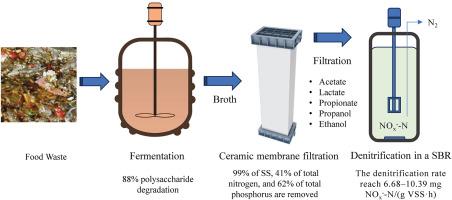Efficient conversion from food waste to composite carbon source through rapid fermentation and ceramic membrane filtration
IF 8.1
2区 环境科学与生态学
Q1 ENVIRONMENTAL SCIENCES
引用次数: 0
Abstract
Anaerobic fermentation of food waste (FW) produces a broth rich in small-molecule organic substances, which has the potential as a composite carbon source for denitrification in wastewater treatment. In this study, the idea was tested by optimizing the fermentation process at different hydraulic residence time (HRT), refining fermentation broth through ceramic membrane filtration, and comparing the performance of fermentation filtrate and other commercial carbon sources. A short HRT of 3 days was a suitable fermentation condition with 88% polysaccharide degradation. Acetic acid contributed 40% of soluble chemical oxygen demand in the fermentation broth, followed by ethanol, propanol, lactic acid, and propionic acid, and the five products accounted for 80%. Ceramic membrane filtration can recover more than 70% of dissolved organic matter and more than 60% of small molecular organic matter and simultaneously remove 99% of SS, 41% of total nitrogen, and 62% of total phosphorus. At the rapid degradation stage, the denitrification rates reached 6.68–10.39 mg NOx−-N/(g VSS·h), which was on par with commercial carbon sources. The short fermentation and the rapid membrane separation were integrated to create an efficient treatment system, which provided a feasible pathway to utilize FW combining wastewater treatment.

通过快速发酵和陶瓷膜过滤,将厨余垃圾高效转化为复合碳源。
厨余垃圾(FW)厌氧发酵产生富含小分子有机物的发酵液,有可能成为废水处理中脱氮的复合碳源。本研究通过优化不同水力停留时间(HRT)下的发酵过程、通过陶瓷膜过滤精制发酵液以及比较发酵滤液和其他商业碳源的性能,对这一想法进行了验证。3 天的短水力停留时间是一个合适的发酵条件,多糖降解率达 88%。发酵液中乙酸占可溶性化学需氧量的 40%,其次是乙醇、丙醇、乳酸和丙酸,五种产物占 80%。陶瓷膜过滤可回收 70% 以上的溶解有机物和 60% 以上的小分子有机物,同时去除 99% 的 SS、41% 的总氮和 62% 的总磷。在快速降解阶段,反硝化率达到 6.68-10.39 mg NOx--N/(g VSS-h),与商业碳源相当。短时间发酵与快速膜分离相结合,形成了一个高效的处理系统,为结合废水处理利用 FW 提供了一条可行的途径。
本文章由计算机程序翻译,如有差异,请以英文原文为准。
求助全文
约1分钟内获得全文
求助全文
来源期刊

Chemosphere
环境科学-环境科学
CiteScore
15.80
自引率
8.00%
发文量
4975
审稿时长
3.4 months
期刊介绍:
Chemosphere, being an international multidisciplinary journal, is dedicated to publishing original communications and review articles on chemicals in the environment. The scope covers a wide range of topics, including the identification, quantification, behavior, fate, toxicology, treatment, and remediation of chemicals in the bio-, hydro-, litho-, and atmosphere, ensuring the broad dissemination of research in this field.
 求助内容:
求助内容: 应助结果提醒方式:
应助结果提醒方式:


